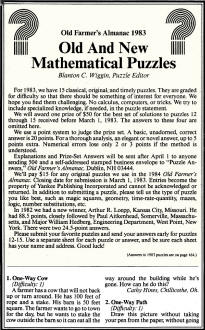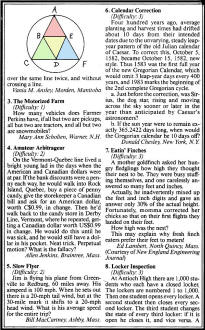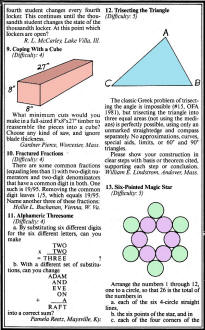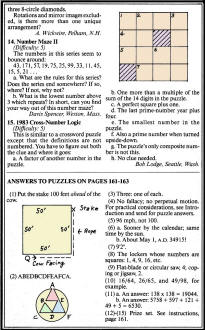Old and New Mathematical Puzzles
|
||
This set of "Old and New Mathematical Puzzles" appeared in the 1983 issue of The Old Farmers Almanac (OFA). In addition to daily times for sunrise and sunset, moonrise and moonset, crop planting tables, animal gestation periods, significant events in history, weather predictions and trends, and many other bits of actual scientific information, the OFA included a set of puzzles requiring a wide range of mathematical and reasoning skills to solve (Difficulty: 1 through 5). Difficulty: 1, might be something like tracing the path along a geographical line drawing without crossing any lines. Difficulty: 3, likely involves some degree of mathematics, often a bit of algebra like solving three equations in three unknowns. Difficulty: 5, being the highest level of challenge, typically does not have solutions provided as do the others. Those solutions are solicited from readers and "the best" for each is published in the next year of publication. Old and New Mathematical Puzzles
For 1983, we have 15 classical, original - and timely puzzles. They are graded for difficulty so that there should be something of interest for everyone. We hope you find them challenging. No calculus, computers, or tricks. We try to include specialized knowledge, if needed, in the puzzle statement. We will award one prize of $50 for the best set of solutions to puzzles 12 through 15 received before March 1, 1983. The answers to these four are omitted here. We use a point system to judge the prize set. A basic, unadorned, correct answer is 20 points. For a thorough analysis, an elegant or novel answer, up to 5 points extra. Numerical errors lose only 2 or 3 points if the method is understood. Explanations and Prize-Set Answers will be sent after April 1 to anyone sending 50¢ and a self-addressed stamped business envelope to "Puzzle Answers," Old Farmer's Almanac, Dublin, NH 03444. We'll pay $15 for any original puzzles we use in the 1984 Old Farmer's Almanac. Closing date for submission is March 1, 1983. Entries become the property of Yankee Publishing Incorporated and cannot be acknowledged or returned. In addition to submitting a puzzle, please tell us the type of puzzle you like best, such as. magic squares, geometry, time-rate-quantity, mazes, .logic, number substitutions, etc.
Please submit your favorite puzzles and send your answers early for puzzles 12-15. Use a separate sheet for each puzzle or answer, and be sure each sheet has your name and address. Good luck! 1.One-Way Cow (Difficulty: 1) A farmer has a cow that will not back up or turn around. He has 100 feet of rope and a stake. His barn is 50 feet square. The farmer wants to go to town for the day, but he wants to stake the cow outside the barn so it can eat all the way around the building while he's gone. How can he do this? Cathy Hines, Chillicothe, Oh. 2. One-Way Path (Difficulty: 1) Draw this picture without taking your pen from the paper, without going over the same line twice, and without crossing a line. Vania M. Ansley, Morden, Manitoba 3. The Motorized Farm (Difficulty: 1) How many vehicles does Farmer Perkins have, if all but two are pickups, all but two are tractors, and all but two are snowmobiles? Mary Ann Scholten, Warner, N.H. 4. Amateur Arbitrageur (Difficulty: 2) On the Vermont-Quebec line lived a bright young lad in the days when the American and Canadian dollars were at par. If the bank discounts were a penny each way, he would walk into Rock Island, Quebec, buy a piece of penny candy, give the storekeeper a Canadian bill and ask for an American dollar, worth C$0.99,in change. Then he'd walk back to the candy store in Derby Line, Vermont, where he repeated, getting a Canadian dollar worth US$0.99 in change. He would do this until he was sick, and he would still have a dollar in his pocket. Neat trick. Perpetual motion? What is the fallacy? Allen Jenkins, Braintree, Mass. 5. Slow Flyer (Difficulty: 2) Jim is flying his plane from Greenville to Redburg, 60 miles away. His airspeed is 100 mph. When he sets out there is a 20-mph tail wind, but at the 30-mile mark it shifts to a 20-mph head wind. What is his average speed for the entire trip? Bill MacCartney, Ashby, Mass. 6. Calendar Correction (Difficulty: 3) Four hundred years ago, average planting and harvest times had drifted about 10 days from their intended dates due to the unvarying, steady leap-year pattern of the old Julian calendar of Caesar. To correct this, October 5, 1582, became October 15, 1582, new style. Thus 1583 was the first full year of the new Gregorian Calendar, which would omit 3 leap-year days every 400 years, and 1983 marks the beginning of the 2nd complete Gregorian cycle. a. Just before the correction, was Sirius, the dog star, rising and moving across the sky sooner or later in the year than anticipated by Caesar's astronomers? b. If the sun year were to remain exactly 365.2422 days long, when would the Gregorian calendar be 10 days off? Donald Chesley, New York, N. Y 7. Eatin' Finches (Difficulty: 3) A mother goldfinch asked her hungry fledglings how high they thought their nest to be. They were busy stuffing themselves, and one carelessly answered so many feet and inches. Actually, he inadvertently mixed up the feet and inch digits and gave an answer only 30% of the actual height. Fortunately, momma corrected her chicks so that on their first flights they landed on their feet. How high was the nest? This may explain why fresh finch eaters prefer their feet to meters! Ed Lambert, North Quincy, Mass. (Courtesy of New England Engineering Journal) 8. Locker Inspection (Difficulty: 3) At Antioch High there are 1,000 students who each have a dosed locker. The lockers are numbered 1 to 1,000. Then one student opens every locker. A second student then closes every second locker. The third student changes the state of every third locker: if it is open he closes it, and vice versa. A fourth student changes every fourth locker. This continues until the thousandth student changes the state of the thousandth locker. At this point which lockers are open? R. L. McCarley, Lake Villa, Ill. 9. Coping With a Cube (Difficulty: 4) What minimum cuts would you make in a full-sized 8"x8"x27" timber to reassemble the pieces into a cube? Choose any kind of saw, and ignore blade thickness. Gardner Pierce, Worcester, Mass. 10. Fractured Fractions (Difficulty: 4) There are some common fractions (equaling less than 1) with two-digit numerators and two-digit denominators that have a common digit in both. One such is 19/95. Removing the common digit leaves 1/5, which equals 19/95. Name another three of these fractions. Hollie L. Buchanan. Vienna, W Va. 11. Alphameric Threesome (Difficulty: 4) a. By substituting six different digits for the six different letters, can you make b. With a different set of substitutions, can you change into a correct sum? - Pamela Reetz, Maysville, Ky. 12. Trisecting the Triangle (Difficulty: 5) The classic Greek problem of trisecting the angle is impossible (#15, OFA 1981), but trisecting the triangle into three equal areas (not using the medians) is perfectly possible, using only an unmarked straightedge and compass separately. No approximations, curves, special aids, limits, or 60° and 90° triangles. Please show your construction in clear steps with basis or theorem cited, supporting each step or conclusion. William E. Lindstrom, Andover, Mass. 13. Six-Pointed Magic Star (Difficulty: 5) Arrange the numbers 1 through 12, one to a circle, so that 26 is the total of the numbers in a. each of the six 4-circle straight lines, b. the six points of the star, and in c. each of the four comers of the three 8-circle diamonds. Rotations and mirror images excluded, is there more than one unique arrangement? A. Wickwire, Pelham, NH. 14. Number Maze II (Difficulty: 5) The numbers in this series seem to bounce around: 43, 171, 57,19, 75, 25, 99, 33, 11, 45, 15, 5, 21 ... a. What are the rules for this series? Does the series end somewhere? If so, where? If not, why not? b. What is the lowest number above 3 which repeats? In short, can you find your way out of this number maze? Davis Spencer, Weston, Mass. 15. 1983 Cross-Number Logic (Difficulty: 5) This is similar to a crossword puzzle except that the definitions are not numbered. You have to figure out both the clue and where it goes: a. A factor of another number in the puzzle. b. One more than a multiple of the sum of the 14 digits in the puzzle. c. A perfect square plus one. d. The last prime-number year plus four. e. The smallest number in the puzzle. f. Also a prime number when turned upside-down. g. The puzzle's only composite number is not this. h. No clue needed. Bob Lodge, Seattle, Wash. Answers to Puzzles on Pages 161-163 (1) Put the stake 100 feet ahead of the cow. (2) ABEDBCDFEAFCA. (3) Three: one of each. (4) No fallacy; no perpetual motion. For practical considerations, see Introduction and send for puzzle answers. (5) 96 mph, not 100. (6) a. Sooner by the calendar; same time by the sun. b. About May 1, A.D. 34915! (7) 9'2". (8) The lockers whose numbers are squares: 1, 4, 9, 16, etc. (9) Flat-blade or circular saw; 4; coping or jigsaw, 2. (10) 16/64, 26/65, and 49/98, for example. (11) a. An answer: 138 x 138 = 19044. b. An answer: 5758 + 597 + 121 + 49 + 5 = 6530. (12)-(15) Prize set. See instructions, page 161.
Posted January 29, 2024 |
||




